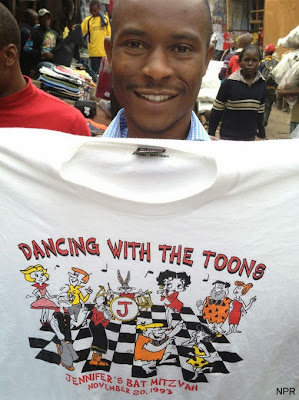It’s no secret that many of those cotton t-shirts we wear here in the First World ultimately get donated and wind up in the Third World. Thousands of t-shirts that get printed each year celebrating the losing team in the Super Bowl, NBA Finals and World Series usually get shipped to Africa. And for decades the customary bar mitzvah and bat mitzvah t-shirts that accumulate in teens’ closets have been donated to the Salvation Army or Goodwill to be sent to Africa or into impoverished neighborhoods throughout North America. When I lived in New York City, it was not unusual for me to see a homeless man wearing a donated bar mitzvah t-shirt or a Jewish youth group shirt that had been donated before the owner went off to college.
National Public Radio (NPR) did a story the other day on the fate of these donated t-shirts that wind up in Africa. It wasn’t the first time such a story had been done. Almost three years ago Mother Jones ran a story titled “When Hooters T-Shirts Go to Africa: Donate an old t-shirt in the US? Someday it might travel to a country like Liberia.” And over ten years ago the New York Times published a story that also tracked donated clothes to the Third World in George Packer’s article “How Susie Bayer’s T-Shirt Ended Up on Yusuf Mama’s Back.” The basic premise of these stories is that once you donate an old sweatshirt or t-shirt to the Salvation Army or Goodwill, your old, used clothing takes on a new life somewhere else. We often don’t think of who’s wearing our old winter coat that we donated, but it does make for an interesting story.
